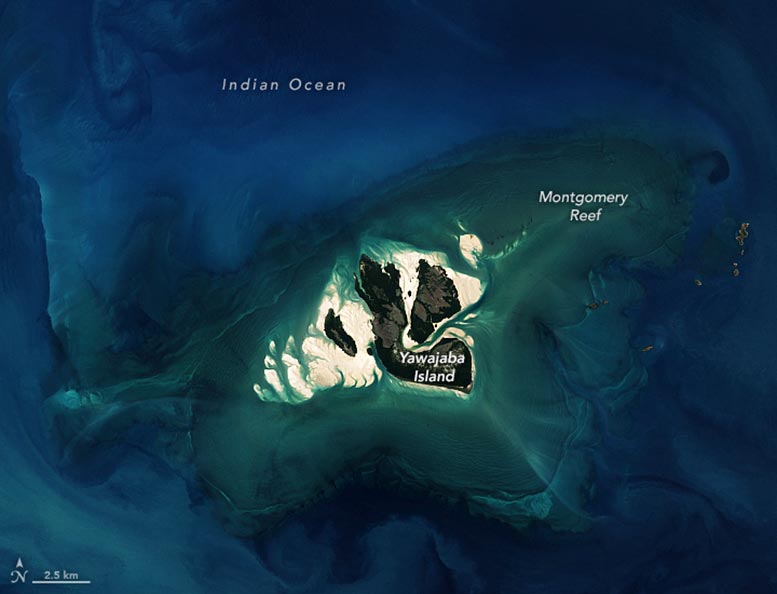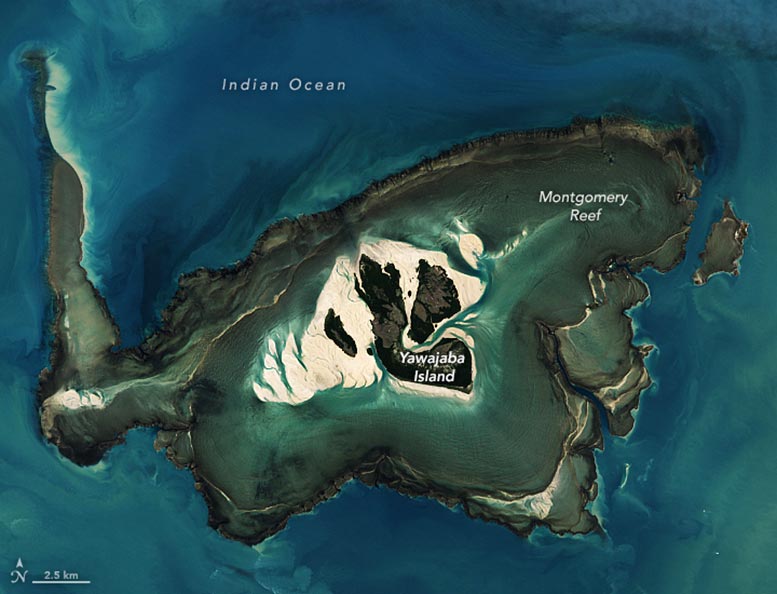

Large tidal swings expose a plateau-shaped reef around Australia’s Yawajaba island at low tide.
The Kimberley coast of Western Australia has one of the largest tidal ranges in Australia and the world. At Montgomery Reef, in Collier Bay, water levels drop sharply at low tide, allowing the plateau-shaped reef to emerge several meters above the water level.
Tidal shifts are particularly noticeable in this area because of the flat, shelf-like terrain along the Kimberley coast. This pair of images shows the reef when the tide was high (left) and low (right) in 2024. The high tide image was captured by the OLI-2 (Operational Land Imager-2) on Landsat 9 on April 21; the OLI (Operational Land Imager) on Landsat 8 acquired the low tide image on April 29.
Ecological Dynamics at Low Tide
When the tide rises, the sandy islets and main mangrove-covered island, Yawajaba, within Montgomery Reef are visible, but the reef is mostly underwater and out of view. During low tides, the water level can drop by as much as 10 meters (33 feet), revealing the expansive terraced structure of the reef and the network of shallow lagoons surrounding Yawajaba.
As the tide pours off the structure, the outward flow of water can grow tumultuous. At times, whitewater cascading off the reef forms dozens of rivulets and small waterfalls that flow into deeper channels within the reef, a spectacle for tourists and a hazard for wildlife. Fish, sea snakes, turtles, blacktop reef sharks, dugongs, and other creatures can be seen thrashing and tumbling off the coral platform as the water drains. Animals are occasionally left stranded on exposed reef during low tide.
Geological and Biological Features of Montgomery Reef
The structure of Montgomery Reef is not entirely a product of coral. The feature was once a flat-topped terrestrial mesa made of dolomite and sandstone that formed some 1.8 billion years ago. More recently, this ancient structure has been encrusted with a veneer of marine life, especially rhodolith—a free-floating type of coralline algae that adds much of the structure to the perimeter of the reef.
Communities of several types of hard and soft corals cover about 20 percent of the reef’s surface, particularly along the edges of pools and channels where the water is deeper. Corals along the Kimberley coast, like those found on Montgomery Reef, are known for being unusually resilient compared to corals in other parts of Australia and the world. They have adapted to withstand the swings in temperature that come with tidal variations, and to endure the exposure to elevated ultraviolet light and winds during low tide.
But even these rugged corals are not indestructible. Following a marine heat wave in 2016, which was part of the third global bleaching event, scientists reported widespread coral bleaching at Montgomery Reef and other coral communities on the Kimberley coast.
Monitoring and Future Concerns
In April 2024, the National Oceanic and Atmospheric Administration (NOAA) confirmed the world’s corals were in the midst of a fourth global bleaching event, but local reports of bleaching at Montgomery Reef have not emerged yet. Heat stress maps from NOAA’s Coral Reef Watch indicate that corals to the southwest in Western Australia and those closer to the equator faced a greater risk of bleaching in mid-May 2024.
NASA Earth Observatory images by Lauren Dauphin, using Landsat data from the U.S. Geological Survey.